Navigation
Magic Porthole Coral Reef Contest Winners Announced
Horizon International today announced the winners of its coral reef contest, the Magic Porthole’s First Environment Achievement Contest held in honor of the International Year of the Reef (IYOR) 2008.
Horizon International today announced the winners of its coral reef contest, the Magic Porthole’s First Environment Achievement Contest held in honor of the International Year of the Reef (IYOR) 2008. Individuals of all ages and organizations were invited to participate. Prize winners were chosen for best efforts and the impact of their actions. Aquariums, museums, coral reef organizations and individuals offered prizes.
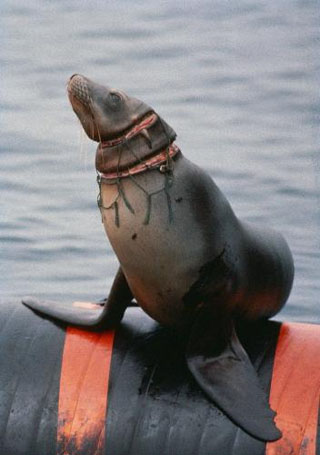 |
| Sea Lion Ensnared in Gillnet Today, the Save Our Seas Foundation, in Geneva, and other organizations worldwide, are working to further reduce and eliminate deadly drift nets. Photo (c) Save Our Seas Ltd./ Tom Campbell/Marine Photobank." |
The first prize winner is “Fair Catch,” a “Responsible fishing campaign to improve the health of Hawaii's coral reefs.” SeaWeb, The Nature Conservancy and Malama Hawaii are collaborators on this effort to restore Hawaii’s near shore ocean by encouraging responsible fishing practices and to support actions that protect reefs and fishes from further decline. Their entry was submitted by campaign director Shannon Crownover, who is with The Nature Conservancy in Honolulu.
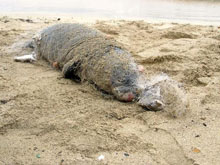 |
| This endangered monk seal pup was the first born on Oahu, Hawaii in eight years. Despite efforts to protect her by a team of volunteers, she became entangled and drowned in a lay gill net left unattended overnight in nearshore waters. The Fair Catch campaign worked to ban such lay gill nets, a type of nylon monofilament mesh net used by fishers in the region. Photo by D.B. Dunlap |
The campaign launched in 2006 claimed its first victory in 2007 with the passage of severe restrictions on indiscriminate and wasteful gill nets.
As of February 2009, the Fair Catch campaign is working with The Nature Conservancy at large on how to effect policy change to restore the marine environment. It “expects future campaigns, including one to protect shellfish reefs in May 2009,” Ms. Crownover said. “This was the first social marketing campaign that Malama Hawaii engaged in, and …it plans to use similar techniques in future environmental protection efforts.” She also said that SeaWeb is interested in links between this Hawaii campaign and its Asia Pacific program.
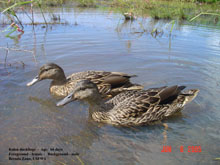 |
| The Koloa maoli, an endangered wetland bird, Photo by Brenda Zaun US Fish and Wildlife Service |
Pauline Sato of Malama Hawaii said, “The Fair Catch campaign gave us the tools and credibility to pursue other social marketing projects in Hawaii. We are currently engaged in a project protecting a unique coastline on the northwestern tip of the island of O'ahu, Ka'ena Point, via a first-of-its-kind (for Hawai'i) predator-proof fence.” They are also pursuing two new statewide campaigns to protect an endangered wetland bird, the Koloa maoli, and issues of sustainability that connects conservation to Hawaiian culture.
A case study about the Fair Catch initiative is presented on the Horizon Solutions Site at www.solutions-site.org.
The second prize winner is Eve Heaton, a fourth grade teacher at Mossy Oaks Elementary School in Beaufort, South Carolina whose winning education project involves her own students.
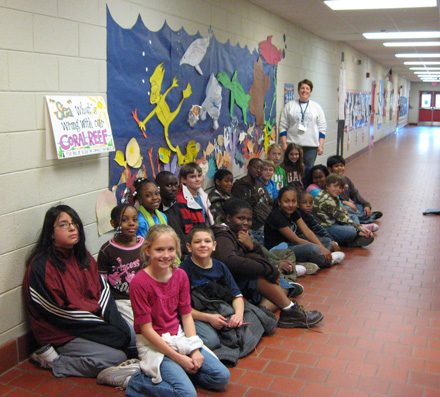 |
| Ms. Heaton's class below their coral reef banner. Photo by Eve Heaton |
She tied her curriculum into the theme of the International Year of the Reef (IYOR) by creating opportunities for her students to explore coral reefs in the classroom and on location during the school year. They learned, for example, about Gray's Reef off the Atlantic coast.
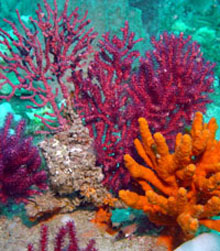 |
| Sponge Group Gray's Reef Gray's Reef National Marine Sanctuary is the only natural area protected off the Georgia coast. The 17.5 square nautical miles (about 11,000 acres) of Gray's Reef is just a tiny part of the vast Atlantic Ocean off the Georgia coast, yet its value as a natural marine habitat is recognized both nationally and internationally. Text and Photo NOAA |
Her personal Web page describing her initiatives with her students is available at www.mrsheatonsclass.com.
Winner of the third prize is Laura R. Hunt for an education, outreach and fundraising initiative for Texas coral reef conservation.
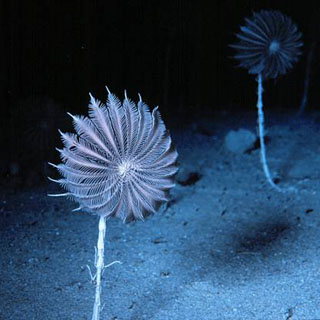 |
| Flower Garden Banks National Marine Sanctuary, located about 110 miles off the coasts of Texas and Louisiana, harbors the northernmost coral reefs in the continental United States and serves as a regional reservoir of shallow water Caribbean reef fishes and invertebrates. The coral reefs rise to within 55 feet of the surface and form the basis for a complex, yet balanced ecosystem. The Banks themselves are surface expressions of salt domes whose formation began 160 to 170 million years ago in what was a shallow sea, subject to evaporation. Today it has become a premier diving destination and attracts scientists from around the world. This Encyclopedia is meant to provide natural history information, video clips, still images, and additional resources to find more information about the marine life found within the sanctuary. Text and Photo; NOAA |
“The idea for the event began when I saw the Reef Fest website, www.reeffest.org, and decided that I wanted to organize an event in my own area,” she said.
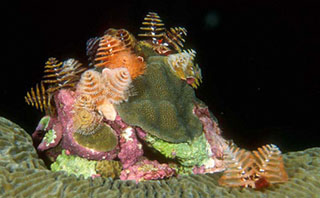 |
| Christmas tree worms are encased in living coral. build hidden calcareous tubes on coral reefs. They have two spiral-like, feathery appendages that extend to 1-1/2 inches and look like colorful Christmas trees. The color of these appendages varies between brown, orange, white, and maroon. They extend out of their tubes to catch food but quickly retract into these tubes when disturbed. Christmas tree worms are found in all many types of coral from 5 to 100 feet below the surface. They eat Phytoplankton, microscopic plants. Text NOAA and Photo NOAA by Joyce and Frank Burek |
“All proceeds from the event went to Reef Fest which will allocate the funds to Texas Flower Gardens Sanctuary.”
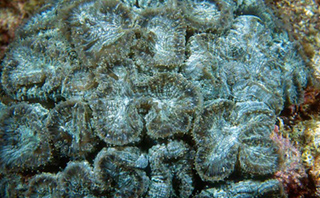 |
| Spiny flower corals are fleshy corals which form colonies that can reach 2 feet in diameter. The individual polyps are between 1/2 inch and 4 inches wide and they are usually grey in color with hints of blue or green. The polyps tend to grow tightly together. Spiny flower corals are one of the less common species of coral found at Flower Gardens. They typically grow between the large heads of brain and star corals. Nutrients provided by symbiotic algae, planktonic animals. Text NOAA and Photo NOAA by Joyce and Frank Burek |
The first prize winner of receives a trip to a coral reef on board Research Vessel Tiburon with Captain Tim Taylor. The second prize winner receives free tuition at Sanibel Sea School.
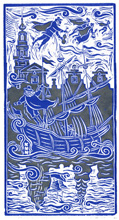 |
| A hand colored woodcut on Japanese paper entitle "Old New Amsterdam." It is part of a tryptich by artist Sasha Meret.. |
And, the third prize winner receives art work by Sasha Meret.
In addition, prize winners receive books and t-shirts from the Wild Dolphin Foundation, Wild Dolphin.org, First Collectors’ Edition Magic Porthole Coral Reef Playing Cards, and undersea guides, caps, and t-shirts from Reef Check. Family passes to Birch Aquarium at Scripps were also contributed for the contest.
Magic Porthole, a program of Horizon International, provides engaging experiences for discoveries about the lives of frogfish, cleaning gobies, turtles, seahorses, sharks, and many of the myriad other coral reef creatures while encouraging reef preservation with online and offline videos, games, and resources.
On the Magic Porthole web site visitors can play seahorse games contributed by the Birch Aquarium at Scripps, engage in contests and explore resources Reef Check and IYOR, learn about water using a flash page from UNEP, TUNZA, and CEE (Center for Environmental Education, India), and have fun with resources from NOAA/National Ocean Science and others. A special feature on dolphins provided by The Wild Dolphin Project tells about the importance of coral reefs to dolphins.
The Magic Porthole Web site is recognized as an American Library Association’s (ALA) Great Web Site for Kids .
Search
Latest articles
Agriculture
- World Water Week: Healthy ecosystems essential to human health: from coronavirus to malnutrition Online session Wednesday 24 August 17:00-18:20
- World Water Week: Healthy ecosystems essential to human health: from coronavirus to malnutrition Online session Wednesday 24 August 17:00-18:20
Air Pollution
- "Water and Sanitation-Related Diseases and the Changing Environment: Challenges, Interventions, and Preventive Measures" Volume 2 Is Now Available
- Global Innovation Exchange Co-Created by Horizon International, USAID, Bill and Melinda Gates Foundation and Others
Biodiversity
- World Water Week: Healthy ecosystems essential to human health: from coronavirus to malnutrition Online session Wednesday 24 August 17:00-18:20
- Mangrove Action Project Collaborates to Restore and Preserve Mangrove Ecosystems
Desertification
- World Water Week: Healthy ecosystems essential to human health: from coronavirus to malnutrition Online session Wednesday 24 August 17:00-18:20
- UN Food Systems Summit Receives Over 1,200 Ideas to Help Meet Sustainable Development Goals
Endangered Species
- Mangrove Action Project Collaborates to Restore and Preserve Mangrove Ecosystems
- Coral Research in Palau offers a “Glimmer of Hope”
Energy
- Global Innovation Exchange Co-Created by Horizon International, USAID, Bill and Melinda Gates Foundation and Others
- Wildlife Preservation in Southeast Nova Scotia
Exhibits
- Global Innovation Exchange Co-Created by Horizon International, USAID, Bill and Melinda Gates Foundation and Others
- Coral Reefs
Forests
- NASA Satellites Reveal Major Shifts in Global Freshwater Updated June 2020
- Global Innovation Exchange Co-Created by Horizon International, USAID, Bill and Melinda Gates Foundation and Others
Global Climate Change
- World Water Week: Healthy ecosystems essential to human health: from coronavirus to malnutrition Online session Wednesday 24 August 17:00-18:20
- Mangrove Action Project Collaborates to Restore and Preserve Mangrove Ecosystems
Global Health
- World Water Week: Healthy ecosystems essential to human health: from coronavirus to malnutrition Online session Wednesday 24 August 17:00-18:20
- More than 400 schoolgirls, family and teachers rescued from Afghanistan by small coalition
Industry
- "Water and Sanitation-Related Diseases and the Changing Environment: Challenges, Interventions, and Preventive Measures" Volume 2 Is Now Available
- Global Innovation Exchange Co-Created by Horizon International, USAID, Bill and Melinda Gates Foundation and Others
Natural Disaster Relief
- STOP ATTACKS ON HEALTH CARE IN UKRAINE
- Global Innovation Exchange Co-Created by Horizon International, USAID, Bill and Melinda Gates Foundation and Others
News and Special Reports
- World Water Week: Healthy ecosystems essential to human health: from coronavirus to malnutrition Online session Wednesday 24 August 17:00-18:20
- STOP ATTACKS ON HEALTH CARE IN UKRAINE
Oceans, Coral Reefs
- World Water Week: Healthy ecosystems essential to human health: from coronavirus to malnutrition Online session Wednesday 24 August 17:00-18:20
- Mangrove Action Project Collaborates to Restore and Preserve Mangrove Ecosystems
Pollution
- Zakaria Ouedraogo of Burkina Faso Produces Film “Nzoue Fiyen: Water Not Drinkable”
- "Water and Sanitation-Related Diseases and the Changing Environment: Challenges, Interventions, and Preventive Measures" Volume 2 Is Now Available
Population
- "Water and Sanitation-Related Diseases and the Changing Environment: Challenges, Interventions, and Preventive Measures" Volume 2 Is Now Available
- "Water and Sanitation-Related Diseases and the Changing Environment: Challenges, Interventions, and Preventive Measures" Volume 2 Is Now Available
Public Health
- Honouring the visionary behind India’s sanitation revolution
- Honouring the visionary behind India’s sanitation revolution
Rivers
- World Water Week: Healthy ecosystems essential to human health: from coronavirus to malnutrition Online session Wednesday 24 August 17:00-18:20
- Mangrove Action Project Collaborates to Restore and Preserve Mangrove Ecosystems
Sanitation
- Honouring the visionary behind India’s sanitation revolution
- Honouring the visionary behind India’s sanitation revolution
Toxic Chemicals
- "Water and Sanitation-Related Diseases and the Changing Environment: Challenges, Interventions, and Preventive Measures" Volume 2 Is Now Available
- Actions to Prevent Polluted Drinking Water in the United States
Transportation
- "Water and Sanitation-Related Diseases and the Changing Environment: Challenges, Interventions, and Preventive Measures" Volume 2 Is Now Available
- Urbanization Provides Opportunities for Transition to a Green Economy, Says New Report
Waste Management
- Honouring the visionary behind India’s sanitation revolution
- Honouring the visionary behind India’s sanitation revolution
Water
- Honouring the visionary behind India’s sanitation revolution
- Honouring the visionary behind India’s sanitation revolution
Water and Sanitation
- Honouring the visionary behind India’s sanitation revolution
- Honouring the visionary behind India’s sanitation revolution

